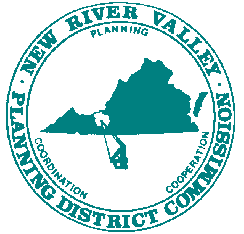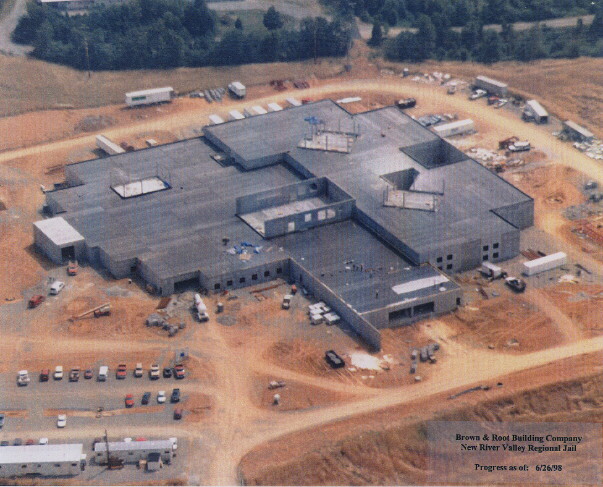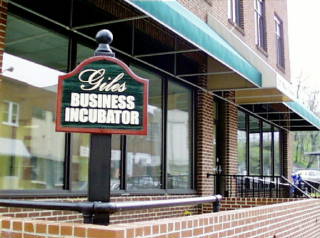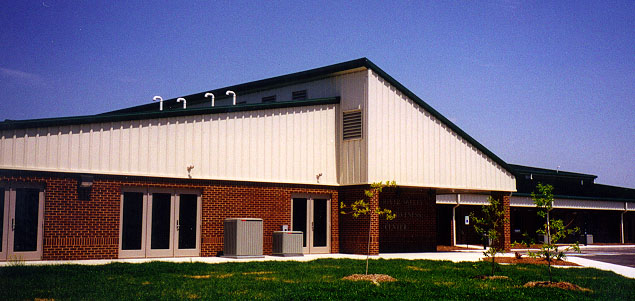




Inside....

On September 15, 1999 the Commission passed its 30th year of providing services to the local governments and people
of the New River Valley. The Commission was formed in 1969 as a result of legislation recommended by the
Metropolitan Area Study Commission in 1967. The Study Commission, chaired by T. Marshall Hahn, Jr., President
of Virginia Tech, found that it was important that "localities ... work together in matters involving area-wide resources
and needs in the interest of local government ...." The focus of the Study Commission was on economic advancement
and creating a beneficial environment.
The Planning District Commission is responsible for area-wide planning in the categories of social, economic, and
physical development of the District; coordinating Federal and State grant-in-aid programs; and providing a forum
for review of mutual concerns. The Study reports that "The Planning District Commission alone cannot be expected
to solve the major problems but it should provide the foundation for implementing such solutions."
Reflecting on the Commission's history, one finds that it has undertaken area-wide planning in all of the categories:
social services for the elderly, criminal justice and police training, alcohol safety action, community corrections, and
juvenile and adult detention. Physical planning in such areas as water quality, environmental area identification, and
utility system feasibility has been provided. Also, economic development projects were accomplished, involving the
Economic Development Alliance, Competitiveness Partnership, Foreign Trade Zone, NRV Commerce Park and NRV
Competitiveness Center.
In the area of grants-in-aid, the Commission has assisted local governments and others in obtaining hundreds of
millions of dollars to address the most pressing of problems. As State and Federal funds become more scarce, the
Commission has explored ways to work with private foundations to assist in the continued development of our region
and its citizens.
The following report outlines the results of the Commission's FY99 work program. The new millennium and century promise to be exciting times in the New River Valley.
Sincerely,
David W. Rundgren, Executive Director
Main Menu
Virginia's First Regional Industrial Facility Authority
Virginia's First Regional Industrial Facility Authority has been created by fifteen
Southwestern Virginia localities covering the area from the City of Roanoke to the Town
of Narrows and from the County of Roanoke to the County of Bland. Each of the participating localities is
equal at the Authority table, having two members and paying an annual fee of $5,000. The purpose of the
Authority is to undertake industrial development projects which are of a scope and size that no locality could
undertake individually.
In 1997, the General Assembly passed Senator Trumbo's Virginia's Industrial Facility Act. The Act put in place the provisions which would encourage local governments to jointly invest in industrial facilities. One of the provisions of the Act is the formation of an industrial facility authority by localities wishing to take such joint actions. A proposed Authority was submitted to the Secretary of the Commonwealth and on September 28, 1998, the Secretary of the Commonwealth authorized the creation of Virginia's First Regional Industrial Facility Authority. Bylaws were prepared to provide the basis for cooperative development of the region and adopted in February 1999. The Authority is in the process of developing its first project, the NRV Commerce park. Main Menu
The New River Valley Regional Jail held its grand opening on April 9, 1999. Lt. Governor John Hager gave
the keynote address and cut the red, white and blue ribbon to open the $25 million facility. The 449-bed
facility, serving the counties of Bland, Carroll, Floyd, Giles, Grayson, Pulaski and Wythe, and the City of
Radford, began accepting prisoners on April 27th.

Inmates are getting acclimated to the jail and several inmates have graduated from General Education Diploma
classes. Also, Alcoholics Anonymous and Bible study classes are being offered to inmates. In addition, a work
release program for the inmates has been established.
The last details of jail construction have been completed, and PDC staff continue to provide administrative assistance to the jail on a month-to-month basis until all administration can be smoothly transferred to the jail
staff. Main Menu
The NRV Magnet School for Technology is a partnership between New River Community College and the
counties of Bland, Carroll, Wythe, Giles, Floyd, Pulaski, and Montgomery, and the City of Radford. These
organizations have joined to provide their students training and dual enrollments for technology related course
work. The School is providing an important and desirable educational experience. Dr. Bill Asbury, who retired
last year as Pulaski County School Superintendent, is the Project Director. The NRV Magnet School, located
at New River Community College (NRCC), has two important aspects: (1) it represents unprecedented
cooperation among localities, public schools, the community college, and local universities; and (2) it serves
a diverse mix of students from high school vocational students to college engineering graduates.
The first classes began in January of 1999 and attracted 125 students. The School received Statewide attention
when it was awarded the Rufus W. Beamer Excellence Award by the Virginia Board of Education. Also
recognized by the Board of Education was the partnership between educational institutions and economic
development organizations in the region in developing this program. The School represents a new wave of the
future that will be necessary for the region to continue to attract quality technology employers.
The fall semester was the first semester that information on the program was made available to all students in
the region. It is anticipated that the school will attract at least 250 students. The NRV Magnet School
provides courses in high tech subjects which lead to skills certification. Programs to be offered include fiber
optics, information systems, semiconductor technologies, computer repair, and network technician. These five
new programs are underpinned and supported by the excellent and widely recognized electrical /
instrumentation / electronics program cluster at NRCC.
Financial support for this project comes from two sources: $20,000 from The New Century Consortium (Virginia's Economic Bridge) and $22,000 from the New River Valley Regional Competitiveness Partnership. The General Assembly allocated $100,000 to NRCC to plan a program for the Institute for Excellence, plan a building which may include the Magnet School program, a workforce development program for the New River Valley, and possibly the Southwest VA Governor's School for Math, Science, and Technology. Main Menu
Virginia's New River Valley Regional Competitiveness Partnership
Virginia's New River Valley Regional Competitiveness Partnership is an organization formed by the local governments consisting of representatives of the New River Valley Planning District Commission and the New River Valley Economic Development Alliance. The Partnership reports on the status of regional projects and encourages other regional projects through the investment of the funds provided to the Partnership by the General Assembly. Last year funds were utilized to assist in the establishment of the New River Valley Airport as a User Fee Airport and Foreign Trade Zone, the planning for the Technology Magnet School, support of the New River Valley Competitiveness Center, the organization and initial program of the NRV Visitor Alliance, and the planning of the Commerce Park. Main Menu
Vision 2020, the regional strategic plan the NRVPDC developed in the early 1990s, has served as the foundation for much of its continuing regional cooperation. The NRVPDC promised that Vision 2020 would be a living, breathing plan, not a static, sit-on-the-shelf plan. As the projects listed below demonstrate, Vision 2020 continues to breathe life into the region, helping us to build a healthy community into the 21st century. Main Menu
Kellogg Managing Information with Rural America (MIRA) Program
Under the Kellogg MIRA Program, the citizens of the New River Valley have been busily pursuing the goals
of enhancing access to information technology for the grassroots community, and encouraging formal and
informal networks of people and organizations across the region.
An application was developed in October 1997 and the NRVPDC was awarded a Kellogg MIRA grant in
March 1998. The New River Valley Kellogg MIRA Steering Committee took over program guidance and
oversight in April 1998 with representation from each community team and a few at-large community
members. Community teams were formed in ten communities across the New River Valley. These teams are
autonomous and self-organizing. All jurisdictions within the New River Valley are represented and each team
has worked to bring diversity to its membership. The community development leadership workshop began June
20, 1998. These events were held monthly through November 1998 and each community team was responsible
for notifying its membership about these events. The opportunity to bring this diverse group of people together
on a relatively balanced playing field (most people had never participated in a program like this before) set the
stage for open and inquiring dialogue. The community teams became a group of people united in an effort to
improve their community, gain personal skills, and sometimes, complain about training room acoustics and
food. Phase II of this program was the award and administration of mini-grants for each team. Grant
applications were due on January 15, 1999, and were reviewed by a local subcommittee of the Steering
Committee. Each team received $15,000 to develop a project in its community. A community celebration was
held April 16, 1999. This event celebrated the completion of the workshops and the awards of the mini-grants.
Team awards and individual achievements were part of the program. The event was held in Floyd at the
beautiful Chateau Morrisette and a sit-down dinner was part of the event. Over 150 team members participated
in this event. The mini-grant phase of this project was completed in August 1999.
The Community Foundation of the New River Valley (CFNRV) and the NRVPDC provided staff support that
helped guide this program. The CFNRV and NRVPDC provided important support and general information
dissemination to the Steering Committee and the community teams in the beginning of this process. These
organizations have continued to provide continuity and general administrative support to the program to ensure
successful implementation of this program. Main Menu
The New River was designated an American Heritage River by President Clinton in July of 1998. The
NRVPDC provided staff support for the development of the New River Workplan. This was published and
distributed at an all-day workshop sponsored by Congressman Rick Boucher in late July 1999. The community
participation was broad and deep, due in large part to the community trust that was built by the MIRA work.
We were the only community along the entire New River to have any African American community members
participate in workplan development, and our meetings were consistently well-attended.
The New River Valley has four representatives to the Board of New River Community Partners, which is the
nonprofit organization charged with providing assistance and support to New River Communities. These
representatives are Lesley Howard, David Ridpath, David Rundgren, and Llyn Sharp.
The workplan is available by contacting either Lesley Howard or Dave Rundgren at the NRVPDC. Main Menu
Grassroots Leadership Development Initiative
The NRVPDC's work on the MIRA project also provided the base for a Grassroots Leadership Development Initiative, EAGLES (Energized Active Grassroots Leaders Engaged Systematically). NRVPDC staff collaborated with staff from the Community Foundation of the New River Valley (CFNRV) to prepare and submit an application to the Mary Reynolds Babcock Foundation for this two-year project. The full amount requested was awarded to the grantee, the CFNRV, in June, 1999. The project's mission is to provide personal development opportunities as a path to community development. An endowed fund of at least $250,000 will also be established at the CFNRV to sustain the program after the Mary Reynolds Babcock Foundation monies have expired. Main Menu
The New River Valley Economic Development Alliance has been leading an effort to seek "User Fee
Airport/Port of Entry" and "Foreign Trade Zone" status for the New River Valley Airport. In support of this
effort, the NRVPDC conducted a survey of area industries engaged in international trade, developed the initial
draft of the Foreign Trade Zone application, and facilitated development of budget and funding information.
Several existing manufacturers in the region could realize benefits from the New River Valley Foreign Trade
Zone. Approximately 50 firms in the New River Valley are involved in import and/or export activities. The
establishment of a Foreign Trade Zone in the New River Valley will allow
participating companies to reduce import duties and thus leave them with
more funds available for investment in employees and capital improvements.
Existing manufacturers in the New River Valley will be able to participate by
having their sites designated as special purpose subzones of the New River
Valley Foreign Trade Zone. Subzone benefits for private businesses can
include: cash flow savings; elimination of duties for merchandise exported
from a subzone; and reduction of duties, in some cases, for merchandise sold
for use in the U.S.
From an economic development perspective, Foreign Trade Zone benefits will be a useful marketing tool in
attracting new businesses to the New River Valley. Development of the Foreign Trade Zone will facilitate
expansion of the New River Valley's already significant level of international trade while helping to diversify
the economy and create jobs. Main Menu
The New River Valley Competitiveness Center, located at the New River Industrial Park in Pulaski County, held a ribbon cutting ceremony on April 12, 1999 with Congressman Rick Boucher serving as the keynote speaker. The Center opened with one tenant and had seven by the end of June and continues to grow.
The Center, owned by the New River Valley Development Corporation, is a 31,081 square foot facility designed as a "gateway" to the New River Valley and is an example of innovative planning to incorporate a mix of uses. The facility includes an industrial incubator containing 16,000 square feet, office space for several regional agencies consisting of 5,090 square feet, and shared spaces containing 9,991 square feet. The facility is designed to serve employee and visitor needs. The site allows for a 20,000 square foot expansion of the industrial incubator space. The Competitiveness Center was financed through a loan from Rural Development and a grant award from the Economic Development Administration. Main Menu
Established in November 1997, the Giles Business Incubator (GBI) officially opened its doors in February
1998. With only 6,468 leasable square feet, the incubator reached 55% occupancy within one year. Though
eight tenants have entered the program, GBI recognized one as meeting the graduation requirements. This
tenant graduated in February 1999 and relocated to Pearisburg, Virginia. Current occupancy consists of five
tenants. Incubator tenants have created eleven new jobs, four part-time and seven full-time.
 The GBI offers classes in the spring and fall of each year. These classes include topics on stress management,
financial options, recordkeeping, tax issues, employment law, insurance, business start-up, and marketing.
The GBI offers classes in the spring and fall of each year. These classes include topics on stress management,
financial options, recordkeeping, tax issues, employment law, insurance, business start-up, and marketing.
Though located in Narrows, Virginia, GBI receives support from the Giles County Board of Supervisors and
the Industrial Development Authority. Operating funds are received from donations, rents, fees, grants, and
public funding. The Giles Business Incubator and the Town of Narrows were recipients of grants from the
Appalachian Regional Commission Entrepreneurial Initiative and the George and Effie Seay Foundation
amounting to $44,575 with dispersements over two fiscal year periods.
Strategic alliances and networking are essential to the GBI's continued success. Local funding sources for its
entrepreneurs are the National Bank of Blacksburg and New Enterprises Fund, Inc. Both institutions are
invaluable in their support of small business start-ups. Jonathan Simmons of the Radford Small Business
Development Center is a valuable resource for the entrepreneurs in the incubator. His networking and referrals
have enabled one business to expand its product availability to a national level.
The Giles Business Incubator's mission is to be a business resource center committed to the growth and development of beginning or expanding businesses in Giles County. Staying true to this mission, the program continues in the next millennium.bridging innovation with tradition. Main Menu
The Jacksonville Center, located in Floyd County, is a regionally focused economic development project
promoting rural culture, arts, and community. The Center is located just outside the Town of Floyd on Route
8. It occupies a little over four acres of land with a 10,000 square foot partially remodeled barn, a "creamery,"
and an office building.
The Center has established the first floor of the Barn facility as a rural cultural business incubator and
presently has four tenants. Main Menu
Narrows Downtown Revitalization continued this year with the Giles Business Incubator gaining new tenants
and several downtown buildings and businesses receiving façade improvements. Only two components of the
original Community Development Block Grant remain: demolition of a blighted building and streetscape
improvements. The demolition is slated to get underway in 99-00; the streetscape improvements will be
coordinated with VDOT's Route 61 realignment project. Main Menu
Localities from the Roanoke and New River Valleys had been discussing the desirability of investing in regional
"Commerce Parks" for a number of years. A Commerce Park was envisioned as an industrial property having
a size and scope that individual localities could not afford in terms of both money and the time it may take to
find the industrial firm to locate there.
With the Virginia's First Regional Industrial Facility Authority in place, the participating localities focused attention on the goal of developing a Regional Commerce Park. The efforts included: (1) obtaining options for lands adjacent to the New River Valley Airport and the Foreign Trade Zone; and (2) the preparation of applications for financial assistance to support the acquisition and development of the facility. The Authority has received a $1.375 million grant from the Department of Housing and Community Development's Industrial Site Development Fund (ISDF), and submitted applications to Rural Development for $4 million in loan funds, the Appalachian Regional Commission, and the Economic Development Administration to undertake the initial phase of the New River Valley Commerce Park project. The Authority has established a Participation Agreement process which allows Authority members to make individual project investment decisions. Main Menu
The Commission staff has provided services to the five Directors of Social Services as they evaluate their welfare clients who need to find employment. One of the projects which is being developed in the region is the Work Keys job profile and worker assessment system. With an assessment, clients and other potential workers have an evaluation of their skills as compared to labor force needs in the region. The system allows targeted job searches and provides a definition of training needs. The development of this program is being undertaken by New River Community College in association with the secondary school divisions. In addition to jobs, health care, transportation and child care are major concerns. An application was prepared to provide loan funds for the purchase of vehicles. This project was not funded, however it can have many side benefits and is still under consideration. Child care is a problem in both affordability and availability for second shift workers. Welfare Reform Phase II is on the horizon and the region is expected to seek additional funding to address the needs of welfare and working-poor populations. Main Menu
The City of Radford, serving as the regional fiscal agent, applied for and was awarded a $700,000 Community Development Block Grant to construct a transitional housing facility. This project will provide safe, transitional housing for victims of domestic violence and their families who are working to build violence-free lives. It will also provide intensive case management for residents, providing the "wrap around" services and skills training needed to help these women become self-sufficient, contributing members of society. Main Menu
The Giles County Comprehensive Plan was formally adopted by the Giles County Board of Supervisors on
February 18, 1999. This concluded a two year planning process involving the citizens and planning
commission working together to create a working land use plan for the future of Giles County. Main Menu
Pulaski County Planning Commission members were presented with the final draft of the background data of
the Comprehensive Plan Update in the Spring ('99). The County and PDC staff are working together with the
planning commission to complete the Comprehensive Plan Update. In addition, PDC staff are currently
working on various types of mapping for the Comprehensive Plan. Main Menu
The Floyd County Planning Commission has been working to update their Comprehensive Plan. Increasing
population is one of the issues being discussed. Since 1990, the County's population has increased from
12,000 to 13,200 persons. The Commission sees the increase in population resulting in the division of farms
throughout the County. Maintaining the rural character and the provision of services are issues of concern,
along with providing job opportunities. Main Menu
Revised goals and objectives for the Town's Comprehensive Plan were presented to the Planning Commission,
as well as a land use map illustrating existing conditions and a map showing improved and unimproved land
in the Dublin area. A future land use map was later presented and accepted. The highlights of this
Comprehensive Plan Update include encouraging residential development within a one mile radius of the
Town's incorporated boundaries, encouraging commercial development along US 11 outside of the Town's
eastern boundary, and emphasizing revitalization of Old Town Dublin in the Town's historic Central Business
District. Adoption of the Plan is expected for late Fall. Main Menu
The Rich Creek Planning Commission finalized the Goals and Objectives section of its Comprehensive Plan and reviewed several land use maps for the existing land use section. The final draft of the Plan was presented in late September, with adoption scheduled for early November. Main Menu
The Floyd County Planning Commission and Board of Supervisors have been working on provisions in the County Subdivision Ordinance to address the increasing number of parcels being developed along secondary roads, and the number of access points being created. Issues of adequate water and wastewater facilities and administrative processes are also being addressed. Main Menu
The NRVPDC provided grant-writing assistance to the Friends of Claytor Lake (FOCL) in developing a
funding application for the Virginia Department of Environmental Quality's Citizen Monitoring Grant
Program. The successful application effort provided funds to help support FOCL's citizen-based water quality
monitoring program which focuses on Claytor Lake. Main Menu
This integrated solid waste management and innovative recycling technical assistance project has been
operating within the NRVPDC since 1992, and continues to receive funding from a variety of sources.
Services include: direct on-site technical assistance, training workshops, waste audits, waste exchanges,
information resources, and publications.
The following publications are available on request:
The NRVPDC receives funding support from the Virginia Department of Transportation for transportation
planning activities in the New River Valley. The Transportation Technical Advisory Committee (TAC) advises
the NRVPDC on transportation matters and serves as a forum for the discussion of regional transportation
issues. Main Menu
During FY 1999 staff gathered and developed information including land use, traffic volume, and intersection
level of service. The corridor study report will be finalized in early FY 2000. Route 611/Bob White Boulevard
serves as a significant gateway to the Town of Pulaski from the Dublin, Claytor Lake, and Newbern areas.
Between Route F047 and Route 99, Route 611/Bob White Boulevard provides a link between residential
communities, as well as access to industrial and commercial areas. Route 611 also provides access to the
Dublin Industrial Park area from the Exit 101 interchange on Interstate 81. Main Menu
The TAC developed a set of comments on regional primary highway improvements. After review and approval by the NRVPDC, the comments were presented to the Commonwealth Transportation Board at the annual Pre-Allocation Hearing in Salem. Main Menu
After nearly 30 years at 1612 Wadsworth Street, the New River Valley Planning District Commission relocated its offices to the New River Valley Competitiveness Center's regional office space in Pulaski County at 6580 Valley Center Drive. The PDC staff began operating out of the new facility April 12, 1999. The facility offers numerous benefits including conference and training room space, shared copier, fax, and high speed network capabilities. Please come by for a visit!

| Statement of FY 98-99 Revenues & Expenditures | |
|---|---|
| Year Ended June 30, 1999 | |
| AMOUNT | |
| REVENUES: | |
| Floyd County | 1,853.00 |
| Giles County | 2,366.00 |
| Montgomery County | 15,000.00 |
| Pulaski County | 14,517.00 |
| City of Radford | 8,778.00 |
| Town of Christiansburg | 8,942.00 |
| Town of Blacksburg | 10,000.00 |
| Town of Pulaski | 5,376.00 |
| Total Local Revenue | 66,832.00 |
| Interest Income | 6,455.00 |
| Contract Income | 288,305.00 |
| Miscellaneous | 4,736.00 |
| Revenue from Commonwealth | 304,947.00 |
| Revenue from Federal Government | 125,245.00 |
| Total Other Revenue | 729,688.00 |
| TOTAL REVENUES | 796,520.00 |
| EXPENDITURES | |
| Salaries | 358,343.43 |
| Benefits | 70,792.87 |
| Travel | 15,642.76 |
| Office Space | 9,687.00 |
| Telephone | 5,889.67 |
| Office Supplies | 11,232.02 |
| Postage | 6,407.22 |
| Printing | 3,673.62 |
| Copies | 20,006.40 |
| Media Ads | 1,387.79 |
| Map Purchases | 254.50 |
| Equip. Rent | 835.79 |
| Equip. Maint. | 5,403.54 |
| Dues & Pubs | 3,248.58 |
| Training | 0.00 |
| Workshops | 0.00 |
| Comm. Comp. | 3,025.00 |
| Insurance | 5,827.00 |
| Depreciation | 3,898.14 |
| Capital Outlay | 2,758.48 |
| Contract Serv. | 102,850.78 |
| Audit Fee | |
| Misc. | 13,199.23 |
| Regional Competitiveness | 238,392.99 |
| TOTAL EXPENDITURES | 886,181.85 |
| RESERVES/FUND BALANCE / BEGINNING OF YEAR | 197,925.00 |
| RESERVES/FUND BALANCE / END OF YEAR | 108,263.15 |
Full Time Part Time If you have any questions or comments regarding this annual report, please contact Jan Reynolds, [email protected] |